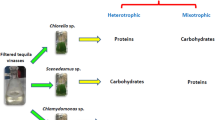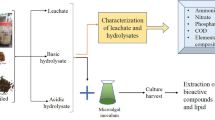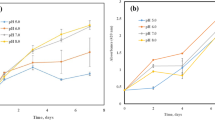Abstract
The supplementation of nutrients from agro-industrial residues is a sustainable strategy to improve cost-benefit microalgae production; nonetheless, developing the appropriate supplementation of residue for each microalgal strain is necessary. In this study, a supply strategy of fruit residue (such as mango, banana, apple, tomato, plum, melon, orange, tangerine, grape, strawberry, cherimoya, pear, pineapple, peach and cucumber) was developed to enhance Chlorella sp. CM18 growth and lipid production in a 5-L photo-bioreactor and simultaneously maximize the efficiencies of nutrient removal processes (chemical oxygen demand [COD], NO3−, PO43−, and SO42−) by this alga. This study demonstrates that the microalga attained the highest removal efficiencies when this residue was diluted at 10% (v/v) with MN medium, attaining 89.07 ± 0.31% (COD), 91.55 ± 0.94% (NO3−), 93.82 ± 0.61% (PO43−), and 76.01 ± 0.68% (SO42−). Under this condition, the highest growth rate of Chlorella sp. was 1.35 ± 0.004 day−1 with a lipid production of 15.60 ± 3.17 mg L−1, demonstrating the feasibility of the culture process with Chlorella sp. CM18 to obtain an effluent possessing characteristics that were below the regulatory limits for the concerned parameters and emphasizing the concept of the sustainable circular economy. Overall, this study establishes a method to valorize the nutrients of fruit residues with the aim of producing biomass and lipids through the cultivation of the microalga Chlorella sp. CM18.





Similar content being viewed by others
Data availability
Data will available upon reasonable request and permission of first—corresponding author.
References
Álvarez-Díaz PD, Ruiz J, Arbib Z, Barragán J, Garrido-Pérez MC, Perales JA (2017) Freshwater microalgae selection for simultaneous wastewater nutrient removal and lipid production. Algal Res 24:477–485
Araujo GS, Santiago CS, Moreira RT, Neto MPD, Fernandes FA (2021) Nutrient removal by Arthrospira platensis cyanobacteria in cassava processing wastewater. J Water Process Eng 40:101826
Bischoff HW, Bold HC (1963) Some soil algae from enchanted rock and related algal species. University of Texas Publications No. 6318. Phycol Stud 4:1–95
Calixto CD, da Silva SJK, de Lira EB, Sassi PGP, Rosenhaim R, da Costa SCF, da Conceição MM, Sassi R (2016) Biochemical compositions and fatty acid profiles in four species of microalgae cultivated on household sewage and agro-industrial residues. Bioresour Technol 221:438–446
Candido C, Lombardi AT (2017) Growth of Chlorella vulgaris in treated conventional and biodigested vinasses. J Appl Phycol 29:45–53
Chandra R, Rohit MV, Swamy YV, Mohan SV (2014) Regulatory function of organic carbon supplementation on biodiesel production during growth and nutrient stress phases of mixotrophic microalgae cultivation. Bioresour Technol 165:279–287
Chang HX, Fu Q, Huang Y, Xia A, Liao Q, Zhu X, Zheng YP, Sun CH (2016) An annular photobioreactor with ion-exchange-membrane for non-touch microalgae cultivation with wastewater. Bioresour Technol 219:668–676
Cheng T, Wei CH, Leiknes T (2017) Polishing of anaerobic secondary effluent by Chlorella vulgaris under low light intensity. Bioresour Technol 241:360–368
Chew KW, Chia SR, Show PL, Ling TC, Arya SS, Chang JS (2018) Food waste compost as an organic nutrient source for the cultivation of Chlorella vulgaris. Bioresour Technol 267:356–362
Chuka-ogwude D, Ogbonna J, Borowitzka MA, Moheimani NR (2020) Screening, acclimation and ammonia tolerance of microalgae grown in food waste digestate. J Appl Phycol 32:3775–3785
Chuka-ogwude D, Mickan BS, Ogbonna JC, Moheimani NR (2022) Developing food waste biorefinery: using optimized inclined thin layer pond to overcome constraints of microalgal biomass production on food waste digestate. J Appl Phycol 34:2917–2928
Coman V, Teleky BE, Mitrea L, Martău GA, Szabo K, Călinoiu LF, Vodnar DC (2020) Bioactive potential of fruit and vegetable wastes. Adv Food Nutr Res 91:157–225
Condori MAM, Valencia MRV, Fernández FGA, Choix FJ (2023) Evaluation of sugarcane vinasse as a medium for enhanced Chlorella sp. growth, lipids production, and process integration. J Appl Phycol 35:581–591
de Medeiros VPB, Pimentel TC, Varandas RCR, Dos Santos SA, de Souza PGT, da Costa SCF, da Conceição MM, Magnani M (2020) Exploiting the use of agro-industrial residues from fruit and vegetables as alternative microalgae culture medium. Food Res Int 137:109722
de Mendonca HV, Assemany P, Abreu M, Couto E, Maciel AM, Duarte RL, dos Santos MG, Reis A (2021) Microalgae in a global world: new solutions for old problems? Renew Energy 165:842–862
Esparza I, Jiménez-Moreno N, Bimbela F, Ancín-Azpilicueta C, Gandía LM (2020) Fruit and vegetable waste management: Conventional and emerging approaches. J Environ Manage 265:110510
Feliciano DMS (2016) Environmental impacts of fruit production in Brazil. In: Ioris A (ed) Agriculture, Environment and Development. Palgrave Macmillan, Cham, pp 149–179
Fu Q, Chang HX, Huang Y, Liao Q, Zhu X, Xia A, Sun YH (2016) A novel self-adaptive microalgae photobioreactor using anion exchange membranes for continuous supply of nutrients. Bioresour Technol 214:629–636
Kamyab H, Din MFM, Hosseini SE, Ghoshal SK, Ashokkumar V, Keyvanfar A, Shafaghat A, Lee CT, Bavafa AA, Majid MZA (2016) Optimum lipid production using agro-industrial wastewater treated microalgae as biofuel substrate. Clean Technol Environ Policy 18:2513–2523
Lau KY, Pleissner D, Lin CSK (2014) Recycling of food waste as nutrients in Chlorella vulgaris cultivation. Bioresour Technol 170:144–151
Li K, Liu Q, Fang F, Luo R, Lu Q, Zhou W, Huo S, Cheng P, Liu J, Addy M, Chen P, Chen D, Ruan R (2019) Microalgae-based wastewater treatment for nutrients recovery: A review. Bioresour Technol 291:121934
Lin YL, Zheng NY, Hsu CH (2021) Torrefaction of fruit peel waste to produce environmentally friendly biofuel. J Clean Prod 284:124676
Mekonnen B, Haddis A, Zeine W (2020) Assessment of the effect of solid waste dump site on surrounding soil and river water quality in Tepi town, Southwest Ethiopia. J Environ Public Health 5157046:9
MIDAGRI (2022) Boletín Estadístico Mensual "El Agro en Cifras" 2022. Ministerio de Desarrollo Agrario y Riego del Perú. https://www.gob.pe/institucion/midagri/informes-publicaciones/2826318-boletin-estadistico-mensual-el-agro-en-cifras-2022 (retrieved on 27 Mar 2023)
Mujtaba G, Rizwan M, Lee K (2015) Simultaneous removal of inorganic nutrients and organic carbon by symbiotic co-culture of Chlorella vulgaris and Pseudomonas putida. Biotechnol Bioproc Eng 20:1114–1122
Nagarajan D, Lee DJ, Chen CY, Chang JS (2020) Resource recovery from wastewaters using microalgae-based approaches: A circular bioeconomy perspective. Bioresour Technol 302:122817
Osundeko O, Dean AP, Davies H, Pittman JK (2014) Acclimation of microalgae to wastewater environments involves increased oxidative stress tolerance activity. Plant Cell Physiol 55:1848–1857
Pang N, Gu X, Chen S, Kirchhoff H, Lei H, Roje S (2019) Exploiting mixotrophy for improving productivities of biomass and co-products of microalgae. Renew Sustain Energy Rev 112:450–460
Plazzotta S, Cottes M, Simeoni P, Manzocco L (2020) Evaluating the environmental and economic impact of fruit and vegetable waste valorisation: The lettuce waste study-case. J Clean Prod 262:121435
Pleissner D, Lam WC, Sun Z, Lin CSK (2013) Food waste as nutrient source in heterotrophic microalgae cultivation. Bioresour Technol 137:139–146
Pleissner D, Lau KY, Lin CSK (2017) Utilization of food waste in continuous flow cultures of the heterotrophic microalga Chlorella pyrenoidosa for saturated and unsaturated fatty acids production. J Clean Prod 142:1417–1424
Posadas E, Bochon S, Coca M, García-González MC, García-Encina PA, Muñoz R (2014) Microalgae-based agro-industrial wastewater treatment: a preliminary screening of biodegradability. J Appl Phycol 26:2335–2345
Rice EW, Baird RB, Eaton AD (2017) Standard methods for the examination of water and wastewater (23rd edn). American Public Health Association (APHA), American Water Works Association (AWWA) and Water Environment Federation (WEF), Washington DC
Rippka R, Deruelles J, Waterbury JB, Herdman M, Stanier RY (1979) Generic assignments, strain histories and properties of pure cultures of cyanobacteria. J Gen Microbiol 111:1–61
Shahid A, Malik S, Zhu H, Xu J, Nawaz MZ, Nawaz S, Alam MA, Mehmood MA (2020) Cultivating microalgae in wastewater for biomass production, pollutant removal, and atmospheric carbon mitigation; a review. Sci Total Environ 704:135303
Sharma R, Oberoi HS, Dhillon GS (2016) Fruit and vegetable processing waste: renewable feed stocks for enzyme production. In: Dhillon GS, Kaur S (eds) Agro-industrial wastes as feedstock for enzyme production. Elsevier, Amsterdam, pp 23–59
SINIA (2022) Reporte: Arequipa, reporte estadístico departamental, diciembre 2022. Sistema Nacional de Información Ambiental – Perú. https://sinia.minam.gob.pe/documentos/arequipa-reporte-estadistico-departamental-diciembre-2022 (retrieved on 25 Apr 2023)
Sloth JK, Jensen HC, Pleissner D, Eriksen NT (2017) Growth and phycocyanin synthesis in the heterotrophic microalga Galdieria sulphuraria on substrates made of food waste from restaurants and bakeries. Bioresour Technol 238:296–305
Wang X, Zhang MM, Sun Z, Liu SF, Qin ZH, Mou JH, Zhou ZG, Lin CSK (2020) Sustainable lipid and lutein production from Chlorella mixotrophic fermentation by food waste hydrolysate. J Hazard Mater 400:123258
Zheng S, Chen S, Zou S, Yan Y, Gao G, He M, Wang C, Chen H, Wang Q (2021) Bioremediation of Pyropia-processing wastewater coupled with lipid production using Chlorella sp. Bioresour Technol 321:124428
Acknowledgments
Marco A. Mamani Condori is grateful to the Universidad Nacional de San Agustín de Arequipa (UNSA).
We would like to thank specialist Francisco Fortunato Mamani Ramos (Peru) for his contribution in building the culture chamber and bioreactors.
Funding
This research did not receive any specific grant from funding agencies in the public or private sectors. This work was funded by the first—corresponding author (Marco Alberto Mamani Condori: Environmental Engineer and Safety Engineer).
Author information
Authors and Affiliations
Contributions
Marco A. Mamani Condori performed the conceptualization, investigation, methodology, experimentation, formal analysis, writing–original manuscript, writing–review & editing. MVG and RNO assisted in monitoring of the experimental data. FJC served as critical reviewer and writing–review & editing the manuscript. All authors read and approved the final manuscript.
Corresponding author
Ethics declarations
Conflict of interest
The authors declare that they have no conflict of interest.
Additional information
Publisher's Note
Springer Nature remains neutral with regard to jurisdictional claims in published maps and institutional affiliations.
Supplementary Information
Below is the link to the electronic supplementary material.
Rights and permissions
Springer Nature or its licensor (e.g. a society or other partner) holds exclusive rights to this article under a publishing agreement with the author(s) or other rightsholder(s); author self-archiving of the accepted manuscript version of this article is solely governed by the terms of such publishing agreement and applicable law.
About this article
Cite this article
Condori, M.A.M., Gutierrez, M.E.V., Oviedo, R.D.N. et al. Valorization of nutrients from fruit residues for the growth and lipid production of Chlorella sp.: A vision of the circular economy in Peru. J Appl Phycol 36, 101–111 (2024). https://doi.org/10.1007/s10811-023-03153-2
Received:
Revised:
Accepted:
Published:
Issue Date:
DOI: https://doi.org/10.1007/s10811-023-03153-2




